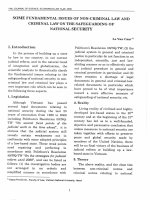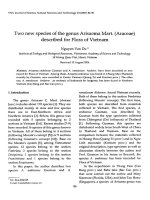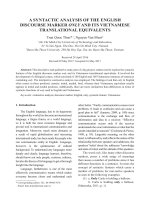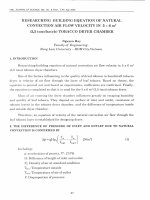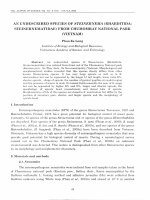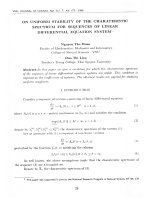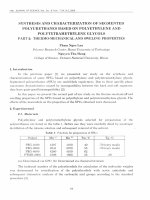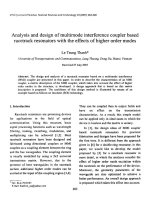DSpace at VNU: X-ray absorption spectroscopies of Mg-Al-Ni hydrotalcite like compound for explaining the generation of surface acid sites
Bạn đang xem bản rút gọn của tài liệu. Xem và tải ngay bản đầy đủ của tài liệu tại đây (841.71 KB, 6 trang )
Korean J. Chem. Eng., 32(4), 1-6 (2015)
DOI: 10.1007/s11814-016-0285-1
pISSN: 0256-1115
eISSN: 1975-7220
INVITED REVIEW PAPER
X-ray absorption spectroscopies of Mg-Al-Ni hydrotalcite like compound
for explaining the generation of surface acid sites
Hong Khanh Dieu Nguyen*,†, Toan Dang Nguyen*, Dung Ngoc Hoang*, Duc Sy Dao**,
Thao Tien Nguyen**, Limphirat Wanwisa***, and Lan Linh Hoang****
*School of Chemical Engineering, Ha Noi University of Science and Technology, Ha Noi, Vietnam
**Faculty of Chemistry, Vietnam National University, Hanoi, Vietnam
***Synchrotron Light Research Institute (Public Organization), Nakhon Ratchasima, Thailand
****Vietnam National Oil and Gas Group, Vietnam
(Received 25 July 2016 • accepted 11 October 2016)
Abstract−Hydrotalcite-like compound containing metal cations such as Mg2+, Al3+ and Ni2+ was characterized using
Ni K-edge EXAFS and in situ Ni K-edge XANES techniques for clarifying its bonding environment around Ni2+ sites
and structure changes during calcination from room temperature to 550 oC, respectively. At the fixed molar ratio of
Mg/Ni/Al of 2/1/1, the results obtained from EXAFS analysis showed a slight blue shift before and after the calcination
at 550 oC and a reduction in white line peak; the best fits of the two samples revealed tiny change in coordination number about 7 for Ni-O path but considerable difference for Ni-Mg(Al) path from about 4.5 to 9.5, confirming a modification from brucite like to mixed oxide structure. On the other hand, bond distances of the Ni-O and Ni-Mg paths
nearly fixed at about 2.06 Å to 3.0 Å reflected stability of the cationic bond order on each plane, but partial collapse and
decomposition of the interlayer formed by water molecules and anion CO32− after the calcination. Linear combination
fit extracted from the in situ Ni K-edge XANES also confirmed the changes along with the calcination such as slow
and fast decreases of brucite fraction at 150 oC and 330 oC, respectively, in corresponding to the mixed oxide fraction
increases. The achieved bonding structures were also applied to explain acid-base occurrence of the hydrotalcite-like
material, especially the acid sites generated by different static charges along with the bonds. The explanation was illustrated by NH3-TPD method.
Keywords: EXAFS, XAS, XANES, Hydrotalcite, Brucite
cite could considerably improve its catalytic properties. Gac [16]
reported that when partially replacing of Mg2+ sites in the beginning hydrotalcite structure by Ni2+, varying of molar Ni/Mg ratios
strongly impacted acid-base property of the formed material, but
the reason for that result remains unclearly. Casenave et al. [4] estimated acid-base properties of Mg-Ni-Al mixed oxides using hydrotalcite as precursor, and a relation between Ni content added to
hydrotalcite and acid-base relation was also reported as introducing Ni leading to strengthen its acidity. The basicity reached a peak
or the highest concentration when the content of Mg and Ni was
low and high, respectively. They recommended a synergy effect of
these metals favoring the basic properties and the role of MgO as
promoter. However, the generation of acid sites was not fully understood. Tanabe’s theory [17] also mentioned the generation and
strengthening of base sites when incorporating of transition metal
ions into MgO, but that of acid sites strongly depend on the bonding environment of the host and guest cations.
Recently, the XAS (X-ray absorption spectroscopy) including
XANES (X-ray absorption near-edge structure) and EXAFS (Extended X-ray absorption fine structure) were used to explaining
the generation of acidity in one of our materials - the meso-structured silica-calcium mixed oxide (MSCMO) catalyst [18], based on
the different charges along the Ca-O-Si bonding system. The bonding environment of metal sites in the material could be well clari-
INTRODUCTION
Hydrotalcite is a natural mineral with general formula Mg6Al2CO3
(OH)16·4(H2O) formed by partial substitution of Al site (Al3+) onto
Mg site (Mg2+) of brucite structure of Mg(OH)2 [1,2]. Because of
many unique and flexible properties, such as ordered crystalline
structure, homogeneous cation distribution, strong base sites, “memory” effect and high surface area, hydrotalcite and hydrotalcite-like
compounds play an important role in adsorption, ion exchange and
catalysis applications [1,3-6]. Actually, for catalysis aspect, these materials have been used in many reactions such as polymerization of
alkene oxides, aldol condensation, steam reforming of ethanol, hydrogenation reactions, oxidation reactions, support for Ziegler-Natta
catalysts [1,7-11]. Recently, a series of hydrotalcite-like compounds
have been used for vegetable oil decarboxylation processes or support for their hydrodeoxygenations to synthesize alternative green
fuels, and their activity has been reported as potential catalysts or
supports, being better and cheaper than commercial catalysts based
on Co, Mo or Ni over alumina or carbon based materials [12-15].
Especially, introducing some metal cations into original hydrotal†
To whom correspondence should be addressed.
E-mail:
Copyright by The Korean Institute of Chemical Engineers.
1
2
H. K. D. Nguyen et al.
fied, confirming the powerful ability of the techniques.
Our purpose in this study focused on clarifying structure characteristics and explaining the generation of acid sites of Mg-Al-Ni
hydrotalcite-like compound and mixed oxide system formed after
its calcination using EXAFS and in situ XANES techniques. The
bond environment around Ni site was deeply analyzed, providing
a reliable aspect for simulating the structure of these materials,
including coordination number, bond distance and bond energy
around Ni sites. The acidity was also confirmed by NH3-TPD
method.
EXPERIMENTAL
1. Preparation of Mg-Ni-Al Hydrotalcite Like Compound
Mg-Ni-Al hydrotalcite material with Mg/Al/Ni molar ratio of
2/1/1 was prepared by co-precipitation method based on the work
of Romero [9]. Mother solutions of Al(III), Ni(II) and Mg(II)
nitrates (0.5; 0.5 and 1 mol/l, respectively) were prepared by dissolving Al(NO3)3·9H2O, Ni(NO3)2·6H2O and Mg(NO3)2·6H2O in
distilled water, respectively. Material precursor was prepared by
homogeneous precipitation method in carbonate alkaline solution, for which solutions containing Ni(II)-Mg(II)-Al(III) in given
ratio were aged at 363 K during 24 h in PP bottle. The reaction was
quenched by submitting the bottles into an ice-bath. The precipitate
was centrifuged, washed with distilled water and dried at 373 K
overnight followed by calcination at 550 oC for 6 hours in air flow.
The materials before and after calcination at 550 oC were termed
as HT3 and HT3-550.
2. Characterizations
In situ XANES measurements were done at beamline 2.2 Timeresolved XAS (TRXAS) of the Siam Photon Source, Thailand. The
synchrotron was operated at 1.2 GeV with maximum ring current of 150 mA. XANES was measured in transmission mode at
Ni K-edge. The XANES spectrum of the samples was taken at every
5 oC when the sample temperature was increased from room temperature to 550 oC. Static EXAFS spectra at Ni K-edge were measured for the as-prepared materials before and after calcination at
beamline 8 XAS of Siam Photon Source. All EXAFS spectra were
measured in transmission mode using double monochromator
equipped with Ge 220. The energy of monochromator was calibrated with Ni foil at K-edge before the measurement. The samples were dilute with BN and put in sample holders whose windows
were Kapton.
XANES spectra of in situ experiment were analyzed by using a
linear combination fitting method. Under high temperature, the
samples underwent structural and chemical changes. At the simplest level of analysis, we assumed that there existed only two species during the heating process. XANES at room temperature and
that at 550 oC after 100 minutes were used as base spectra for initial and final products, respectively. All other spectra taken between
room temperature and 500 oC were composed by the base spectra
at certain fraction. The normalized XANES spectra were fitted using
LCF tool of X-ray analysis software Athena. Energy fitting range
was −20 eV to 30 eV, and no energy shift was included for the fit.
This range covered most features of the XANES Ni K-edge.
EXAFS spectra at Ni K-edge were k3 weighted and fitted in R
June, 2015
space using Artemis, X-ray analysis software in the Ifeffit package.
Fitting k range was 2.9-12.6 Å−1 for all samples. Fourier transforms
of these spectra were fitted from 1 Å - 3±0.05 Å. Initial hydrotalcite
structure used for EXAFS refinement was derived from a wellestablished XRD structure [19]. In the XRD structure of Al3+ and
Mg2+ were not distinguishable. Mg and Ni were included to the
model structure by replacing Al ion. From the initial structure, the
scattering amplitude and phase were calculated using the standard
FEFF 9.6 program [20]. Single scattering paths Ni-O and Ni-X
(X=Ni, Mg) were included for EXAFS refinement. All scattering
paths shared the same fitting energy correction, E0. The refinements
were performed without background fit. To obtain the coordination number, the value of amplitude reduction S02 was fixed for all
samples. This value was extracted by fitting Ni K-edge EXAFS spectrum of Ni foil. In this fit, only Debye-Waller factors of single and
multiple Ni-Ni scattering and path energy correction were fitted.
The extracted value of S02=0.84 was in good agreement with previously used value [21].
Powder XRD of the samples was recorded on a D8 Advance
Bruker diffractometer using Cu Kα (λ=0.15406) radiation. NH3TPD method was measured on a Micromeritics Autocue II 2920
V4.01.
RESULTS AND DISCUSSIONS
1. Powder XRD
Stack powder XRD patterns of the HT3, HT3-550 and standard
hydrotalcite [22] are plotted in Fig. 1. Positions of peaks characterizing for (003), (006), (101) (012)… were all detected in the XRD
pattern of the sample HT3, illustrating a successive hydrotalcite-like
compound preparation. However, the intensity/background ratio
of the peaks in the HT3 was lower than that of the standard corresponding to the effect of the Ni2+ isomorphous substitution onto
the position of Mg2+ [1]. The XRD pattern of the HT3-550 showed
an interesting result relating to collapse of the crystalline structure
when annealing the HT3 at 550 oC. This collapse indicated that the
hydrotalcite-like structure of the sample HT3 was unstable under
Fig. 1. XRD patterns of the HT3, HT3-550 and standard hydrotalcite.
X-ray absorption spectroscopies of Mg-Al-Ni hydrotalcite like compound for explaining the generation of surface acid sites
Fig. 2. The model structure for the EXAFS analysis.
heat treatment. However, the collapse revealed a good agreement
with some studies [23,24].
The results obtained from XRD pattern allowed us to build a
structure simulation of the Mg-Ni-Al hydrotalcite-like compound
(the sample HT3) in the same characteristics with standard hydrotalcite [22]. The only difference was the partial substitution of Ni2+
onto the position of Mg2+. The model in Fig. 2 would be used in
the EXAFS analysis thereafter.
2. In Situ Ni K-edge XANES of the Sample HT3 in Calcination Process
Fig. 3 shows selected XANES spectra of the sample HT3 when
being heated from room temperature to 550 oC. As the temperature
increased, the intensity of white line peak reduced; at the same time
there was a trend of slight blue-shift ~1 eV from room temperature
to 550 oC. The features ranging from 8,390 eV to 8,500 eV were not
changed very much until 350 oC. This reflected as a plateau region
in the fraction plot derived from LCF analysis (Fig. 4).
XANES at room temperature and 550 oC represented hydrotal-
Fig. 3. XANES spectra of HT3 at different temperatures.
3
Fig. 4. Extracted fraction from LCF using room temperature and
550 oC, 100 minute as base spectra.
cite-like structure and mixed oxide species, respectively. As shown
in Fig. 4, a fraction of the hydrotalcite-like structure started to decrease slowly from 150 oC, which led to an increase in fraction of
mixed oxides. The fractions stayed nearly flat from 220 oC to 330 oC.
After this region of temperature population of the hydrotalcite-like
structure quickly decreased, resulting in a quick increase in concentration of mixed oxides. These results were suitable to thermal analysis reported by [24]. In which, the region from room temperature
to about 200 oC was assigned for water removal in both physical
and structural forms; the region occurring at above 350 oC was
described for thermal decomposition of interlayer anions CO32− .
As a consequence, when the interlayer decomposition took place,
the hydrotalcite-like structure could collapse and transform to a
mixed oxide system.
3. Ni K-edge EXAFS Analysis of the Samples HT3 (Before
Calcination) and HT3-550 (After Calcination at 550 oC)
Fig. 5 shows normalized Ni K-edge XAS spectra of the HT3 and
HT3-550 materials. As mentioned above, there was a blue shift about
1 eV from the HT3 to HT3-550 standing for changing from room
temperature to 550 oC.
The radial structure function (RSF) resulting from Fourier transform of the k3-weighted EXAFS in the range of 3-12.6 Å−1 of the
Fig. 5. XAS spectra of the samples HT3 and HT3-550.
Korean J. Chem. Eng.
4
H. K. D. Nguyen et al.
HT3 and HT3-550 samples is shown in Fig. 4. The first peak centered ~1.6 Å resulted from Ni-O scattering. The second peak, which
corresponded to second shell scattering, was contributed by Ni- X
where X was either Ni or Mg. As can be seen, positions of the NiO peak were not changed as hydrotalcite was calcined in the HT3550 material. However, the second peak, which was Ni-Mg, was
shifted to smaller distance as hydrotalcite heated.
EXAFS refinements of the HT3 and HT3-550 were performed
based on given model of the Mg-Ni-Al hydrotalcite like compound
in Fig. 2, in which the Mg and Al sites were indistinguishable. Figs.
6 and 7 showed the k3-weighted χ(k) plots for the two experimental
data and their best fit, respectively. Overall, the structural model
did an excellent job of fitting. A summary of the extracted parameters is presented in Table 1.
For these samples with Mg/Ni/Al molar ratio of 2/1/1, we found
that Ni-Mg scattering was the main contribution of the second shell.
This was verified when both Ni-Mg and Ni-Ni paths were included
Fig. 6. Radial plot of HT3 and HT3-550. These plots were not phase
corrected.
in EXAFS fitting of the second shell. The fit showed that Ni-Ni
contribution was negligible. This was reasonable considering ratio
Fig. 7. EXAFS refinement for samples HT3 and HT3-550 plotted in k-space weighted by k3 and plotted in R-space. Radial plots were not
phase corrected.
Table 1. The best fit results obtained from EXAFS analysis of the HT3 and HT3-550
N
R (Å)
σ 2 (Å2)
ΔE (eV)
R factor
Ni-O
Ni-Mg
6.8(±0.6)
4.4(±0.8)
2.052(±0.007)
3.027(±0.007)
0.0068(±0.0009)
0.0033(±0.0014)
3.79(±1.03)
0.0075
Ni-O
Ni-Mg
7.0(±2.4)
9.5(±2.3)
2.075(±0.016)
2.937(±0.023)
0.0108(±0.0040)
0.0116(±0.0028)
5.51(±2.51)
0.0407
Samples
Scattering paths
HT3
HT3-550
June, 2015
X-ray absorption spectroscopies of Mg-Al-Ni hydrotalcite like compound for explaining the generation of surface acid sites
content of Mg and Ni in the samples.
The coordination numbers of Ni-O in the samples HT3 and
HT3-550 nearly remained, indicating the first shell stability, but
there were large differences with these values of Ni-Mg between
the two samples. The difference indicated considerable changes in
thermal treatment of the HT3 at 550 oC, and the second shell around
Ni2+ sites was unstable, clearly caused by the collapse of the crystalline structure in heating process.
Bond distances of the Ni-O and Ni-Mg paths nearly fixed at
about 2.06 Å to 3.0 Å for both the HT3 and HT3-550 samples,
reflecting the stability of the cationic bond order on each plane in
spite of collapse and partial decomposition of the interlayer formed
by water molecules and anion CO32− after the calcination.
4. Using the Results of the EXAFS Analysis for Explaining the
Acid Generation of the Samples HT3 and HT3-500
A new hypothesis regarding the acidity generation of binary
oxides proposed by Tanabe et al. [17,25] was applied in this study
to explain acidic generation of the materials. In which, the hypothesis predicted what kinds of binary oxides would show acidic properties (Brønsted or Lewis acid) and provided insight regarding the
structure of the acid sites. According to the hypothesis, acidity generation was caused by an excess of a negative or positive charge in
the model structure of a binary oxide. The model structure was
pictured according to the following two postulates: i) The coordination number of a positive element of a metal oxide, C1, and that
of a second metal oxide, C2, were maintained even when mixed;
ii) The coordination number of a negative element (oxygen) of a
major component oxide was retained for all the oxygens in a binary
oxide. Therefore, the bonding structure of the sample HT3 before
calcination could be simulated as follows: Ni-O(6.8)-Mg(4.4). In
which, the coordination number of oxygen was maintained at four
because the Mg site dominates in the material. According to this
simulation, two positive charges of Ni sites were distributed to 6.8
bonds of oxygen, while the two negative charges of the oxygen atom
were distributed to six bonds. Hence, the difference in charge for
one bond of the Ni and O sites was +2/6.8-2/4=−7/34, and for all
6.8 bonds was of −7/34×6.8=−1.4. In this case, Brønsted acidity
was assumed to appear, because some protons were considered to
associate with the oxygens to keep electric neutrality.
The bonding structure of the sample HT3-550 could also be
described as Ni-O(7.0)-Mg(9.5), so the different charge along Ni-O
bond was +2/7.0-2/4=−3/14, and for all 7 bonds around Ni sites
was −3/14×7=−1.5 assigned for Brønsted acid sites on the sample
surface. The different negative charges appeared along Ni-O bonds
of the two samples reflecting a stronger acidity of the HT3-550 than
that of the HT3.
The acidity of the two samples was also confirmed by NH3TPD method as described in Fig. 8. As the obtained results, both
of the sample HT3 and HT3-550 possessed medium and strong
acid sites with all the maximum desorption temperatures ranging
from 200-400 oC and higher than 400 oC. From the maximum
temperature aspect, the sample HT3-550 reached the highest peak
at 544 oC when that of the sample HT3 was 457 oC, indicating the
stronger acidity of the HT3-550 compared with the HT3. Although
the STP NH3 desorbed volume of the HT3 was higher than that
of the HT3-550, the peak concentrations of the two samples were
5
Fig. 8. NH3-TPD diagrams and calculated parameters for maximum
desorption temperatures, STP quantities of desorbed NH3
and peak concentrations of each type of acidity. In which,
strong, medium and weak acid sites correspond to maximum
desorption temperatures of higher than 400 oC, range from
200 to 400 oC and less than 200 oC, respectively.
nearly equal. Therefore, the total acidity of the HT3-550 was higher
than that of the HT3, confirming the obtained results from the
combination of the EXAFS analysis and the Tanabe hypothesis.
CONCLUSION
The Mg-Ni-Al hydrotalcite-like compounds before and after
calcination were characterized for thoroughly understanding their
structure and bonding environment around Ni sites. The incorporation of Ni2+ onto Mg2+ positions remained beginning brucitelike layers, but this crystalline structure was unstable with thermal
treatment followed by collapse into amorphous material. The stability of the coordination numbers and bond distances in the first
shell around Ni2+ sites indicated the stability of the cationic bondKorean J. Chem. Eng.
6
H. K. D. Nguyen et al.
ing order even when the crystalline layers collapsed. The phenomenon presented a transformation from hydrotalcite-like structure
to mixed oxide system during calcination. The structure and coordination of Ni2+ sites generated acid sites on the material surface,
and they also affected acid properties of the material before and
after thermal treatment.
ACKNOWLEDGEMENT
This work was financially supported by the National Foundation
for Science and Technology Development, Vietnam (NAFOSTED)
under grant number 104.05-2013.57.
REFERRENCES
1. F. Cavani, F. Trifiro and A. Vaccari, Catal. Today, 11, 173 (1991).
2. Q. Wang, H. Huang T., Z. Guo, L. Chen, Y. Liu, J. Chang, Z.
Zhong, J. Luo and A. Borgna, Appl. Clay Sci., 55, 18 (1991).
3. S. Albertazzi, F. Basile and A. Vaccari, Interface Sci. Technol., 1, 496
(2004).
4. S. Casenave, H. Martinez, C. Guimon, A. Auroux, V. Hulea, A. Cordoneanu and E. Dumitriu, Thermochim. Acta, 379, 85 (2001).
5. J. Yang and J. Kim, Korean J. Chem. Eng., 23(1), 77 (2006).
6. M. Khitous, Z. Salem and D. Halliche, Korean J. Chem. Eng., 33(2),
638 (2016).
7. O. Kikhtyanin, L. Hora and D. Kubicka, Catal. Commun., 58, 89
(2015).
8. A. Fonseca L., J. David A. B. and E. Moreira A., Appl. Catal. A:
Gen., 388, 77 (2010).
9. A. Romero, M. Jobbagy, M. Laborde, G. Baronetti and N. Amadeo,
Appl. Catal. A: Gen., 470, 398 (2014).
June, 2015
10. J. Yu, J. Li, H. Wei, J. Zheng, H. Su and X. Wang, J. Mol. Catal. A:
Chem., 395, 128 (2014).
11. J. Zhang, S. Wu, Y. Liu and B. Li, Catal. Commun., 35, 23 (2013).
12. J. G. Na, B. E. Yi, J. N. Kim, K. B. Yi, S. Y. Park, J. H. Park, J. N. Kim
and C. H. Ko, Catal. Today, 156, 44 (2010).
13. J. G. Na, J. K. Han, Y. K. Oh, J. H. Park, T. S. Jung, S. S. Han, H. C.
Yoon, S. H. Chung, J. N. Kim and C. H. Ko, Catal. Today, 185, 313
(2012).
14. H. S. Roh, I. H. Eum, D. W. Jeong, B. E. Yi, J. G. Na and C. H. Ko,
Catal. Today, 164, 457 (2011).
15. H. K. D. Nguyen, V. V. Pham and H. T. Do, Catal. Lett., 146 (2016),
DOI:10.1007/s10562-016-1873-8.
16. W. Gac, Appl. Surface Sci., 257, 2875 (2011).
17. K. Tanabe, Solid acids and bases: Their catalytic properties, Kodansha Ltd. (1970).
18. H. K. D. Nguyen and T. D. Nguyen, J. Porous Mater. (2016), DOI:
10.1007/s10934-016-0279-8.
19. M. Bellotto, B. Rebours, O. Clause, J. Lynch, D. Bazin and E. Elkaim,
J. Phys. Chem., 100, 8527 (1996).
20. J. Rehr, J. Kas, M. Prange, A. Sorini, Y. Takimoto and F. Vila,
Comptes Rendus Physique, 10, 548 (2009).
21. G. Sheng, S. Yang, J. Sheng, J. Hu, X. Tan and X. Wang, Environ.
Sci. Technol., 45, 7718 (2011).
22. R. T. Downs, K. L. Bartelmehs and G. V. Gibbs, American Mineralogist, 78, 1104 (1993).
23. C. Enrique D., J. Gallego, F. Mondragon, S Moreno and R. Molina,
Fuel, 89, 592 (2010).
24. L. Obalova, M. Valaskova, F. Kovanda, Z. Lacny and K. Kolinova,
Chem. Papers, 58, 33 (2004).
25. K. Tanabe, M. Misono, Y. Ono and H. Hattori, Studies in Surface
Science and Catalysis, 51 (1989).
